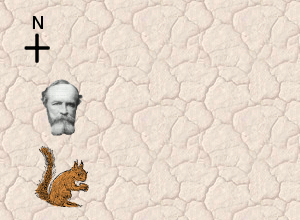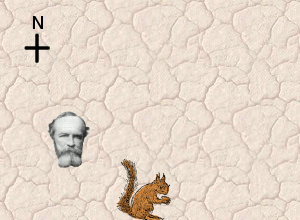(If you came from facebook, click on the “view original post” link to see animations and formatting, the article’s much prettier that way. If you were invited, it’s because I thought you might enjoy a little joyful reminder of the pragmatism you once studied. peace.)
No doubt that one of the most salient sources of the flak that philosophers receive from others is that they are willing to engage in serious discussion about otherwise seemingly worthless minutiae–apparently that includes pragmatists, too. However, when I happened again upon this piece by William James, I simply could not keep myself from asking a few hair-splitting questions.
From William James What Pragmatism Means: Lecture II [1909]
Some years ago, being with a camping party in the mountains, I returned from a solitary ramble to find every one engaged in a ferocious metaphysical dispute. The corpus of the dispute was a squirrel – a live squirrel supposed to be clinging to one side of a tree-trunk; while over against the tree’s opposite side a human being was imagined to stand. This human witness tries to get sight of the squirrel by moving rapidly round the tree, but no matter how fast he goes, the squirrel moves as fast in the opposite direction, and always keeps the tree between himself and the man, so that never a glimpse of him is caught. The resultant metaphysical problem now is this: Does the man go round the squirrel or not? He goes round the tree, sure enough, and the squirrel is on the tree; but does he go round the squirrel? In the unlimited leisure of the wilderness, discussion had been worn threadbare. Every one had taken sides, and was obstinate; and the numbers on both sides were even. Each side, when I appeared therefore appealed to me to make it a majority. Mindful of the scholastic adage that whenever you meet a contradiction you must make a distinction, I immediately sought and found one, as follows: “Which party is right,” I said, “depends on what you practically mean by ‘going round’ the squirrel. If you mean passing from the north of him to the east, then to the south, then to the west, and then to the north of him again, obviously the man does go round him, for he occupies these successive positions. But if on the contrary you mean being first in front of him, then on the right of him, then behind him, then on his left, and finally in front again, it is quite as obvious that the man fails to go round him, for by the compensating movements the squirrel makes, he keeps his belly turned towards the man all the time, and his back turned away. Make the distinction, and there is no occasion for any farther dispute. You are both right and both wrong according as you conceive the verb ‘to go round’ in one practical fashion or the other.”
While I appreciate James’ attempt to illustrate pragmatism by example in this case, I think this is a great opportunity to nitpick a bit, hopefully to better elucidate the meaning and uses of pragmatism.
I have a few outstanding criticisms of James’ use of this story above. First, I am not confident that when James says “depends on what you practically mean by ‘going round’ the squirrel” [emphasis mine], that the word practically brings any additional meaning its sentence, given the assumption that the rest of James’ paragraph is the explanation of what might be meant practically. In other words, James might just as well have said that it “depends on what you mean by ‘going round’ the squirrel”, because there is no difference in meaning between the two sentences. When William James goes on to describe the two potential definitions for “going round”, he supplies definitions which do not really touch on the pragmatic nature of the situation. Each definition is, it seems to me*, metaphysical–as is the question of going round the squirrel (*for the sake of simplicity, I’m proposing a metaphysical v. pragmatic dichotomy here, let’s not bring language/psychology/etc. into the equation).
This is not to say, however, that a pragmatic distinction cannot be made for this metaphysical squirrel question. Indeed, it seems to me that a clarification drawn between what our squirrel-watching friends “mean” and what they “practically mean” might help us get a better grasp on pragmatism, if we can simply get away from the positions James offers us.
I will begin by examining James’ two potential definitions for “going round” the squirrel.
“Going Round”
First, James says one approach is to claim that going round said squirrel means “being first in front of him, then on the right of him, then behind him, then on his left, and finally in front again”. My complaint with this description is that it does not satisfy what we expect when we say “going round”; to illustrate this, I’ve composed a little animation (go easy on me, it’s my first attempt ever) which shows a man–William James himself, actually– “going round a squirrel” by this definition:

I suspect most people will agree that this does not really illustrate what we mean when we say “going round”; therefore, James’ apposite approach to defining the motion is unsuccessful. I should say that there are other options for satisfying the conditions of this apposite definition, but they are more difficult to animate.
Now on to the directional approach to defining “going round”. I have made another animation in a like manner to illustrate a scenario that falls within the bounds of James description “passing from the north of him to the east, then to the south, then to the west, and then to the north of him again”:

Again, I think most of us will agree that this is not what is meant by going round, and, again, this is only one animation of a number of possible configurations.
So…what’s the point?
My intent, here, was not merely to disapprove of William James’ options for defining a man going round a squirrel. Rather, it is to question whether merely defining things in simple relations to each other–and abstracted from the reality of motives and consequences–presents us with metaphysical answers, not pragmatic answers (pragmatic in both the sense of philosophy and of practical use).
My alternative approach, and one which seems to me more indicative of the goals of pragmatism (please correct me if I am wrong), is that the definition of “going round” can be precise, but it must be fluid depending on our ends, our experiences and knowledge, and the prospective consequences of the ends and knowledge which we bring to the table. I’ll attempt to make this clearer with a quick and dirty example.
A truly pragmatic distinction in meaning requires application. In this sense, we might need not only to “go round the squirrel”, but to “go round the squirrel for [some reason] “. For example, if I ask you to go round the squirrel to get a full-view 3D picture for mapping into a computer, and you keep chasing the squirrel around with the camera, but can only ever get the little beast to show its belly to you, then you might rightly tell me “I simply could not get round the squirrel to get those pictures”. Yet if your task was merely to go round the squirrel to set up pylon cameras to get those same images, you might rightly explain to me that you were able to go round the squirrel in order to complete this task, though in this case you never beheld the rodent’s dorsal side. In these cases, the definition is formed through the situation and its consequences; there appears to be a real cash value (on the converse, what does James’ situational and definitional distinction get for us? Perhaps we receive nothing, if we have no interest vested in either consequence).
Perhaps, then, the difference between what we mean and practically mean might not be a difference in denotation. What I mean by going round the squirrel might be confined to a simple definition, but what I practically mean in the given example is that the act of “going round the squirrel” is an act the whose completion belongs to the category of things required in order for me to accomplish my end goal, one of the things which would get me closer to obtaining the cash-value of the 3D computer image of said squirrel.